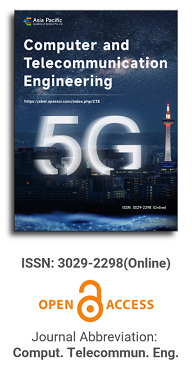
Outage performance of users in CR-NOMA network systems
Vol 2, Issue 4, 2024
Download PDF
Abstract
Non-Orthogonal Multiple Access (NOMA) and Cognitive Radio (CR) technologies present viable solutions to mitigate spectrum scarcity in wireless communication systems. This paper focuses on evaluating the performance of CR-NOMA networks, particularly for user devices operating under a Simultaneous Wireless Information and Power Transfer (SWIPT) framework. We derive explicit mathematical expressions for key performance metrics, including outage probability (OP) and system throughput, as they relate to various power allocation coefficients. Comprehensive simulations are conducted to validate our theoretical findings, revealing that appropriate power allocation significantly impacts user fairness and overall network throughput. The analysis covers a wide range of realistic channel conditions, including Rayleigh fading, to ensure robustness. Additionally, our study addresses the challenge of limiting interference to the primary network by optimizing the transmission power of secondary users while adhering to interference constraints. The results show that the primary user device (D1) consistently outperforms the secondary user device (D2), emphasizing the importance of strategic resource management. These contributions provide deeper insights into the factors affecting outage performance in CR-NOMA systems, offering effective solutions for enhancing the robustness, fairness, and efficiency of next-generation wireless communication networks.
Keywords
References
- Weinberg S. Gravitation and Cosmology. New York: Wiley; 1972.
- Gu YQ. Dynamical Reason for a Cyclic Universe. Symmetry. 2021; 13(12): 2272. doi: 10.3390/sym13122272
- Caldwell RR, Dave R, Steinhardt PJ. Cosmological Imprint of an Energy Component with General Equation of State. Physical Review Letters. 1998; 80(8): 1582–1585. doi: 10.1103/physrevlett.80.1582
- Turner MS. Dark Matter and Dark Energy in the Universe. Physica Scripta. 2000; T85(1): 210. doi: 10.1238/physica.topical.085a00210
- Peebles PJE, Ratra B. The cosmological constant and dark energy. Reviews of Modern Physics. 2003; 75(2): 559–606. doi: 10.1103/revmodphys.75.559
- Carroll SM. Quintessence and the Rest of the World: Suppressing Long-Range Interactions. Physical Review Letters. 1998; 81: 3067. doi: 10.1103/PhysRevLett.81.3067
- Zlatev I, Wang LM, Steinhardt PJ. Quintessence, Cosmic Coincidence, and the Cosmological Constant. Physical Review Letters. 1999; 82: 896-899. doi: 10.1103/PhysRevLett.82.896
- Faraoni V. Inflation and quintessence with nonminimal coupling. Physical Review D. 2000; 62: 023504. doi:10.1103/PhysRevD.62.023504
- Gasperini M, Piazza F, Veneziano G. Quintessence as a runaway dilaton. Physical Review D. 2002; 65: 023508. doi: 10.1103/PhysRevD.65.023508
- Capozziello S. Curvature Quintessence. International Journal of Modern Physics D. 2002; 11: 483. doi: 10.1142/S0218271802002025
- Caldwell RR, Linder EV. Limits of Quintessence. Physical Review letter. 2005; 95: 141301. doi: 10.1103/PhysRevLett.95.141301
- Astashenok AV, Nojiri S, Odintsov SD, Scherrer RJ. Scalar dark energy models mimicking ΛCDM with arbitrary future evolution. Physics Letters B. 2012; 713: 145-153. doi: 10.1016/j.physletb.2012.06.017
- Tsujikawa S. Quintessence: A review. Quantum Gravity. 2013; 30: 214003. doi: 10.1088/0264-9381/30/21/214003
- Shahalam M, Pathak SD, Verma MM, et al. Dynamics of interacting quintessence. The European Physical Journal C. 2015; 75(8): 395. doi: 10.1140/epjc/s10052-015-3608-1
- Han C, Pi S, Sasaki M. Quintessence saves Higgs instability. Physics Letters B. 2019; 791: 314-318. doi: 10.1016/j.physletb.2019.02.037
- Sahni V. The cosmological constant problem and quintessence. Classical and Quantum Gravity. 2002; 19(13): 3435–3448. doi: 10.1088/0264-9381/19/13/304
- S. Turner M, Huterer D. Cosmic Acceleration, Dark Energy, and Fundamental Physics. Journal of the Physical Society of Japan. 2007; 76(11): 111015. doi: 10.1143/jpsj.76.111015
- Ishak M. Remarks on the Formulation of the Cosmological Constant/Dark Energy Problems. Foundations of Physics. 2007; 37(10): 1470–1498. doi: 10.1007/s10701-007-9175-z
- Szydłowski M, Kurek A, Krawiec A. Top ten accelerating cosmological models. Physics Letters B. 2006; 642(3): 171–178. doi: 10.1016/j.physletb.2006.09.052
Supporting Agencies
Cognitive Radio, Cooperative Relaying, Non-Orthogonal Multiple Access, Simultaneous Wireless Information and Power Transfer.
Copyright (c) 2024 Huu Q. Tran
License URL: https://creativecommons.org/licenses/by/4.0/

Prof. Maode Ma
Qatar University, Qatar
The field of computer and telecommunications engineering is rapidly advancing, with the following being some of the latest developments.
more
We are pleased to congratulate the first anniversiry of the journal of Computer and Telecommunication Engineering (CTE).
more
Owing to the tireless dedication of the editor-in-chief, editorial board members, and the in-house editorial team, we are proud to announce the successful online launch of the first issue of Computer and Telecommunication Engineering.
Asia Pacific Academy of Science Pte. Ltd. (APACSCI) specializes in international journal publishing. APACSCI adopts the open access publishing model and provides an important communication bridge for academic groups whose interest fields include engineering, technology, medicine, computer, mathematics, agriculture and forestry, and environment.


.jpg)

.jpg)
